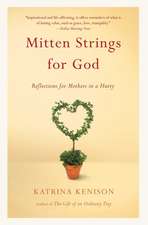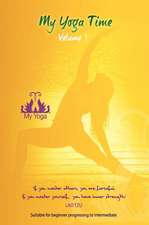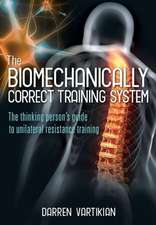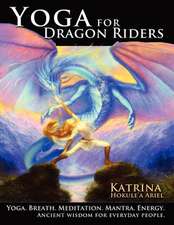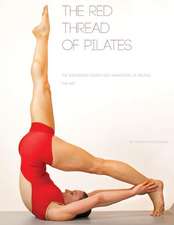Meditations from the Mat: Daily Reflections on the Path of Yoga
Autor Rolf Gates, Katrina Kenisonen Limba Engleză Paperback – 30 noi 2002
As more and more people in the West pursue yoga in its various forms, whether at traditional centers, in the high-powered atmosphere of sports clubs, or on their own, they begin to realize that far from being just another exercise routine, yoga is a discipline of the body and the mind.
The 365 meditations incluided in this book offer a way to integrate the mindfulness that yoga teaches into everyday life. Whether used in the morning to set the tone for the day, during yoga exercise itself, or at the end of the day, during evening reflection, Meditations from the Mat will support and enhance anyone’s yoga journey.
Preț: 117.44 lei
Nou
Puncte Express: 176
Preț estimativ în valută:
22.47€ • 23.46$ • 18.56£
22.47€ • 23.46$ • 18.56£
Carte disponibilă
Livrare economică 25 martie-08 aprilie
Livrare express 11-15 martie pentru 33.33 lei
Preluare comenzi: 021 569.72.76
Specificații
ISBN-13: 9780385721547
ISBN-10: 0385721544
Pagini: 448
Ilustrații: 9 HALFTONES
Dimensiuni: 188 x 191 x 23 mm
Greutate: 0.57 kg
Editura: Anchor Books
ISBN-10: 0385721544
Pagini: 448
Ilustrații: 9 HALFTONES
Dimensiuni: 188 x 191 x 23 mm
Greutate: 0.57 kg
Editura: Anchor Books
Notă biografică
Born in Manhattan, Rolf Gates grew up in the Boston area and attended American University in Washington, D.C. In 1987 he received a degree in American history and his commission in the U.S. Army Infantry from Georgetown University. As a military office he became an Airborne Ranger and served with U.S. forces in Germany. Since then he has worked as an emergency medical technician and an addictions counselor, specializing in adolescents in residential programs. In 1997 he became certified to teach Kripalu yoga. Gates directed the Baptiste Power Yoga Studio in Cambridge for three years and now co-owns and directs Baptiste Power Yoga, The Boston Studio, in Boston, MA. In addition to his weekly teaching schedule he is responsible for the supervision and professional development of the teaching staff of the Boston and Cambridge studios. He appears regularly modeling yoga poses in Natural Health magazine and has conducted workshops throughout the United States and abroad. In 2002, he was named “Best Yoga Teacher” by Boston Magazine. He lives in Boston with his wife, yoga teacher Mariam Gates.
Katrina Kenison has been the annual editor of The Best American Short Stories since 1990. In 1999 she was coeditor, with John Updike, of the national best-seller The Best American Short Stories of the Century. She coedited the anthology Mothers: Twenty Stories of Contemporary Motherhood and is the author of Mitten Strings for God: Reflections for Mothers in a Hurry. Her essays and articles have appeared in O, The Oprah Magazine, where she has been a contributing editor, and in Redbook, Ladies’ Home Journal, Family Circle, and Family Life. Kenison lives outside Boston with her husband, Steven Lewers and their two sons. She began practicing yoga with Rolf Gates in 2000.
Katrina Kenison has been the annual editor of The Best American Short Stories since 1990. In 1999 she was coeditor, with John Updike, of the national best-seller The Best American Short Stories of the Century. She coedited the anthology Mothers: Twenty Stories of Contemporary Motherhood and is the author of Mitten Strings for God: Reflections for Mothers in a Hurry. Her essays and articles have appeared in O, The Oprah Magazine, where she has been a contributing editor, and in Redbook, Ladies’ Home Journal, Family Circle, and Family Life. Kenison lives outside Boston with her husband, Steven Lewers and their two sons. She began practicing yoga with Rolf Gates in 2000.
Extras
PART ONE
THE YAMAS
The Beginning
DAY 1
He that will not apply new remedies must expect new evils; for time is the greatest innovator.
—Sir Francis Bacon
As we move into the twenty-first century, yoga seems to be the West's new remedy. Yet this remedy is in fact over five thousand years old—far older than Islam, even older than Christianity. Today, in yoga studios throughout the West, Sanskrit, one of the oldest written languages, is used as contemporary classroom jargon. So we might ask, Why yoga? And why now?
I believe our hunger for yoga, and our eagerness to embrace yoga as a spiritual practice, are a testament to our growth and our desire for change. In the aftermath of the bloodbath that was the twentieth century, and in the presence of threats posed by more recent events, there is a pressing need for what Buddhist scholar Robert Thurman describes as a "cold revolution." We need a new paradigm, one that will replace our present attachment to imbalance. Yoga is the study of balance, and balance is the aim of all living creatures; it is our home.
The flow of this book follows the course of Patanjali's Yoga Sutras. Written between 500 and 200 b.c., the Sutras codified a spiritual path that was already many centuries old at the time the Sutras were actually written down. Patanjali provides 196 succinct lessons on the nature of the human condition, human potential, and how that potential can be realized. Comprehensive, systematic, and remarkably precise, the Yoga Sutras organize the essence of all spiritual practices into a basic plan for living. You will find nothing in this ancient text that contradicts the precepts of any religion. Instead you will find a step-by-step guide to right living, a guide that complements the goals of any spiritual tradition.
A spiritual practice is one that brings us full circle—not to a new self but, rather, back to the essence of our true selves. Yoga is the practice of celebrating what is. At the end of the hero's journey, he finds that he did not need to go anywhere, that all he sought was inside him all along. Dorothy, having traveled across time and space to the land of Oz, and having struggled desperately to find her way back to Kansas, discovers that she could have gone home at any time. In the end, she learns that her adventures have simply brought her to the point where she can believe this. It is the aim of all spiritual seeking to bring us home, home to the understanding that we already have everything we need.
We are far now from home, and weary from our travels. The sun is setting and there is no destination in sight. Yoga is a lamp lit in the window of our home, dimly glimpsed across the spiritual wilderness in which we wander. At a time when we could not feel further from our home, yoga reminds us that we are already there, that we need simply awaken from our dream of separation, our dream of imperfection. Allow this book to awaken you, to be a light that shines in the darkness, guiding you through your days, pointing you home.
DAY 2
Burning zeal in practice, self-study and study of scriptures, and surrender to God are the acts of yoga.
—B. K. S. Iyengar
The Yoga Sutras outline a plan for living that flows from action to knowledge to liberation. This plan, or path, has eight limbs, which work more like spokes on a wheel than like steps on a ladder. The first four limbs are the limbs of tapas, or spirituality in action. Included here are the yamas and the niyamas, or the five moral restraints and five observances of yoga. The yamas and niyamas are akin to the Ten Commandments and are the true foundation of the yoga student's life.
The next two limbs of tapas are asana and pranayama, the postures and yogic breathing. The yamas and niyamas, asana, and pranayama all combine to form our path of action as we deepen our practice. They are actions taken or not taken with our bodies.
The yamas and niyamas bring us into right relationship with ourselves, others, and the spirit of the universe. The asana refine our bodies, deepen our awareness of the senses, and enhance our powers of concentration. In pranayama we develop control over the flow of our breath, thereby entering into a dance with our life energy. These four practices refresh the body, refine the mind, and bring peace to the heart, allowing us to meet the pressures of life with equanimity.
The next two limbs of the eight-limb path are called svadhyaya, or self-study. They are pratyahara and dharana. Pratyahara literally means turning inward—the mind withdraws from the senses of perception. In the stillness of pratyahara, dharana—or concentration—can be developed. The light of our awareness can begin to shine on our soul. The deepest form of connectedness is now possible.
Dhyana and samadhi form the final spokes of the wheel and comprise the limbs of isvara, the final frontier—the surrender of the individual self to the universal self. Dhyana is meditation, and samadhi is union with the object of meditation—the state in which meditation is no longer necessary, in which we reexperience our primal oneness, we come home.
The eight limbs are a map, but in yoga as in life, the journey is more important than the destination. In Alcoholics Anonymous they say that "we must be willing to grow along spiritual lines." And that is really all that is necessary as we undertake a yoga practice. We must simply remain open to our own spiritual potential and be willing to take action on our own behalf. As the days go by, we will examine each aspect of the eight-limb path in turn. Together we will experience the great adventure, the only adventure, the journey from darkness into light.
DAY 3
Everything all the time . . .
—The Eagles
At first glance, the eight-limb path appears to lend itself to a linear approach. It would seem to make sense: you do the first limb, then you proceed to the second, and so on. In fact, we take up all the limbs together. As the line in the Eagles song goes, we do everything all the time. It's not possible to practice the first two limbs, the yamas and the niyamas, without the support of the practices outlined by the other limbs. As we practice asana and pranayama, the postures and breath work that comprise the third and fourth limbs, we refine our relationship to our body, creating the necessary circumstances for brahmacarya, or moderation, the fourth yama. To practice living in the truth, or satya, the second yama, we must have a mind that has let go of the habit of distraction and developed the habit of concentration. Concentration is deliberately cultivated in dharana, the sixth limb. We must actually do everything all the time.
Our yoga practice makes this possible. Each time we come to the mat, we have an opportunity to work the entire path, moment by moment. As we move through the postures we are constantly enacting each aspect of the path. Our bodies, our breath, our minds, and our choices are being refined in the laboratory that is our yoga mat. As this symphony becomes established on our mats, it becomes established in our lives as well. Driving to work, mailing a letter, meeting a friend for lunch all become part of the uninterrupted flow of our yoga practice. We are doing our yoga all the time.
DAY 4
We are the ones we've been waiting for.
—Hopi elder
Now that you have a sense of how the book will flow, go with it. The Yoga Sutras will set the course as, in our travels, we explore each tributary of the eight-limb path. The daily readings that follow are an invitation to get into the canoe of your practice and flow down the river of yoga. You may go deep, into uncharted waters; you will surely encounter challenges and delights along the way. But first you must get into that canoe and let go. In class I say, Let your practice be a refuge from the need to control. And I suggest the same to you: get out of the driver's seat for a while and enjoy the scenery. Let the river of yoga take you where it will. If you hit whitewater, stay in the canoe and keep paddling. When you enter calm pools, do the same.
At a Native American gathering in Arizona for the 1999 summer solstice, a Hopi elder said: "There is a river flowing now, very fast. It is so great and swift that there are those who will be afraid. They will try to hold on to the shore. They will feel they are being torn apart and suffer greatly. Know that the river has its destination. The elders say we must push off into the middle of the river, keep our eyes open and our heads above the water. See who is in there with you and celebrate. At this time in history we are to take nothing personally, least of all ourselves, for the moment we do that, our spiritual growth comes to a halt. The time of the lone wolf is over. Gather yourselves; banish the word 'struggle' from your attitude and vocabulary. All that we do now must be done in a sacred way and in celebration. We are the ones we've been waiting for."
Now, go to your mat and push off from the shore.
DAY 5
When transgressions hinder, the weight of the imagination should be thrown on the other side.
—Yoga Sutras
In a reflection of the pragmatism that is at the core of all yoga teachings, Patanjali takes a moment, before he begins to outline the necessary restraints of yoga, to tell us what to do if we get into trouble along the way. Whenever we find ourselves ensnared in negative behavior, he suggests, we should increase the amount of time, thought, and energy we direct toward positive behavior. This simple, elegant notion is articulated by Marianne Williamson in her spiritual guidebook A Return to Love. "If you want to end darkness," she writes, "you cannot beat it with a baseball bat, you have to turn on a light." We do not need to enter a showdown with our self-destructive behavior, nor can we deny its existence. We must simply come to know it, and move on. We learn to focus wholeheartedly on positive behavior.
Reading Deepak Chopra's The Seven Spiritual Laws of Success, I came to understand that my own "What's in it for me?" attitude—however subtle or well disguised—was blocking me professionally. Chopra suggests that one of the simplest ways to access grace in any situation is to ask, "How can I be helpful?" Once I saw that my typical M.O. is to ask, "What's in it for me?" I did not enter into a protracted struggle to obliterate the question from my psyche. Instead, I simply embarked on the magnificent journey that begins with the question "How can I be helpful?" As soon as I began to direct my energy and attention to a new question, the old one fell away. The Yoga Sutras suggest that we deliberately turn away from the choice for death and embrace the choice for life.
DAY 6
If you do what you did, you get what you got.
—Anonymous
The Yoga Sutras lay out two aspects of spiritual practice: abhyasa, practice, and vairagya, nonattachment or renunciation. Over two thousand years later, the notions of practice and renunciation are reflected in the twelve-step adage "If you do what you did, you get what you got." Renunciation on its own has no staying power. You can renounce bananas all you like, but if you continue to live in your banana home on your banana street, if you keep your job at the banana warehouse and hang out with your banana-gobbling friends, you'll be eating bananas before you know it. Practice is doing the work. It is following up your intention with action.
Many of us attend a few yoga classes and find that we like the glimpse of another way of life that yoga offers. We are delighted by the way we feel after class and we are pleasantly surprised as certain behaviors start to fall away. Perhaps we no longer need coffee in the morning; or staying out late at night becomes less attractive; or we find ourselves calmer and more compassionate. Suddenly we're convinced that we've hit upon a painless way to solve all our problems. Sadly, this is not the case. Practice is not a substitute for the difficult work of renunciation. The postures and breath work that you do in a typical yoga class will change your life. These practices—asana and pranayama—suffuse us with the energy we need to take on the hard choices and to endure the inevitable highs and lows. What yoga practice will not do, however, is take the place of the hard lessons each of us has to learn in order to mature spiritually. Renunciation is the acid test; it is walking the walk.
A number of my students come to yoga with issues concerning food and body image. Some binge, some starve, some purge; some do all of the above; some just obsess to the point that it blocks their personal growth. In each case there needs to be an ending and a new beginning. The old behavior must be faced and renounced. Yoga practice is not a substitute for that all-important process, but it does support us as we make a commitment to change. Once we take the first step of renunciation, our practice nourishes and sustains us as we are reborn. Practice without renunciation is avoidance. Renunciation without practice is not long-lived. Together, practice and renunciation make all our dreams possible.
DAY 7
Every blade of grass has its angel that bends over it and whispers, "Grow, grow."
—The Talmud
Many of us have spent years trying to ameliorate the world's suffering without first confronting our own. The belief that it is possible to heal the world without healing ourselves first is what the Yoga Sutras call a lack of true knowledge. The truth is, when we are happy we spread happiness, and when we are in pain we spread suffering. If our aim is to alleviate the world's suffering, we must begin with our own minds and bodies. We must do yoga. Each action taken in compliance with the eight-limb path brings with it an increase in our own peace and happiness—and our happiness is welcomed by the universe. We do not need to fear the steps we are about to take. In fact, we will experience each right action, no matter how small or insignificant, as a pleasure and a relief. With each step we take toward the light, the universe rejoices. When we let go of our suffering, we participate in the salvation of all living beings.
THE YAMAS
The Beginning
DAY 1
He that will not apply new remedies must expect new evils; for time is the greatest innovator.
—Sir Francis Bacon
As we move into the twenty-first century, yoga seems to be the West's new remedy. Yet this remedy is in fact over five thousand years old—far older than Islam, even older than Christianity. Today, in yoga studios throughout the West, Sanskrit, one of the oldest written languages, is used as contemporary classroom jargon. So we might ask, Why yoga? And why now?
I believe our hunger for yoga, and our eagerness to embrace yoga as a spiritual practice, are a testament to our growth and our desire for change. In the aftermath of the bloodbath that was the twentieth century, and in the presence of threats posed by more recent events, there is a pressing need for what Buddhist scholar Robert Thurman describes as a "cold revolution." We need a new paradigm, one that will replace our present attachment to imbalance. Yoga is the study of balance, and balance is the aim of all living creatures; it is our home.
The flow of this book follows the course of Patanjali's Yoga Sutras. Written between 500 and 200 b.c., the Sutras codified a spiritual path that was already many centuries old at the time the Sutras were actually written down. Patanjali provides 196 succinct lessons on the nature of the human condition, human potential, and how that potential can be realized. Comprehensive, systematic, and remarkably precise, the Yoga Sutras organize the essence of all spiritual practices into a basic plan for living. You will find nothing in this ancient text that contradicts the precepts of any religion. Instead you will find a step-by-step guide to right living, a guide that complements the goals of any spiritual tradition.
A spiritual practice is one that brings us full circle—not to a new self but, rather, back to the essence of our true selves. Yoga is the practice of celebrating what is. At the end of the hero's journey, he finds that he did not need to go anywhere, that all he sought was inside him all along. Dorothy, having traveled across time and space to the land of Oz, and having struggled desperately to find her way back to Kansas, discovers that she could have gone home at any time. In the end, she learns that her adventures have simply brought her to the point where she can believe this. It is the aim of all spiritual seeking to bring us home, home to the understanding that we already have everything we need.
We are far now from home, and weary from our travels. The sun is setting and there is no destination in sight. Yoga is a lamp lit in the window of our home, dimly glimpsed across the spiritual wilderness in which we wander. At a time when we could not feel further from our home, yoga reminds us that we are already there, that we need simply awaken from our dream of separation, our dream of imperfection. Allow this book to awaken you, to be a light that shines in the darkness, guiding you through your days, pointing you home.
DAY 2
Burning zeal in practice, self-study and study of scriptures, and surrender to God are the acts of yoga.
—B. K. S. Iyengar
The Yoga Sutras outline a plan for living that flows from action to knowledge to liberation. This plan, or path, has eight limbs, which work more like spokes on a wheel than like steps on a ladder. The first four limbs are the limbs of tapas, or spirituality in action. Included here are the yamas and the niyamas, or the five moral restraints and five observances of yoga. The yamas and niyamas are akin to the Ten Commandments and are the true foundation of the yoga student's life.
The next two limbs of tapas are asana and pranayama, the postures and yogic breathing. The yamas and niyamas, asana, and pranayama all combine to form our path of action as we deepen our practice. They are actions taken or not taken with our bodies.
The yamas and niyamas bring us into right relationship with ourselves, others, and the spirit of the universe. The asana refine our bodies, deepen our awareness of the senses, and enhance our powers of concentration. In pranayama we develop control over the flow of our breath, thereby entering into a dance with our life energy. These four practices refresh the body, refine the mind, and bring peace to the heart, allowing us to meet the pressures of life with equanimity.
The next two limbs of the eight-limb path are called svadhyaya, or self-study. They are pratyahara and dharana. Pratyahara literally means turning inward—the mind withdraws from the senses of perception. In the stillness of pratyahara, dharana—or concentration—can be developed. The light of our awareness can begin to shine on our soul. The deepest form of connectedness is now possible.
Dhyana and samadhi form the final spokes of the wheel and comprise the limbs of isvara, the final frontier—the surrender of the individual self to the universal self. Dhyana is meditation, and samadhi is union with the object of meditation—the state in which meditation is no longer necessary, in which we reexperience our primal oneness, we come home.
The eight limbs are a map, but in yoga as in life, the journey is more important than the destination. In Alcoholics Anonymous they say that "we must be willing to grow along spiritual lines." And that is really all that is necessary as we undertake a yoga practice. We must simply remain open to our own spiritual potential and be willing to take action on our own behalf. As the days go by, we will examine each aspect of the eight-limb path in turn. Together we will experience the great adventure, the only adventure, the journey from darkness into light.
DAY 3
Everything all the time . . .
—The Eagles
At first glance, the eight-limb path appears to lend itself to a linear approach. It would seem to make sense: you do the first limb, then you proceed to the second, and so on. In fact, we take up all the limbs together. As the line in the Eagles song goes, we do everything all the time. It's not possible to practice the first two limbs, the yamas and the niyamas, without the support of the practices outlined by the other limbs. As we practice asana and pranayama, the postures and breath work that comprise the third and fourth limbs, we refine our relationship to our body, creating the necessary circumstances for brahmacarya, or moderation, the fourth yama. To practice living in the truth, or satya, the second yama, we must have a mind that has let go of the habit of distraction and developed the habit of concentration. Concentration is deliberately cultivated in dharana, the sixth limb. We must actually do everything all the time.
Our yoga practice makes this possible. Each time we come to the mat, we have an opportunity to work the entire path, moment by moment. As we move through the postures we are constantly enacting each aspect of the path. Our bodies, our breath, our minds, and our choices are being refined in the laboratory that is our yoga mat. As this symphony becomes established on our mats, it becomes established in our lives as well. Driving to work, mailing a letter, meeting a friend for lunch all become part of the uninterrupted flow of our yoga practice. We are doing our yoga all the time.
DAY 4
We are the ones we've been waiting for.
—Hopi elder
Now that you have a sense of how the book will flow, go with it. The Yoga Sutras will set the course as, in our travels, we explore each tributary of the eight-limb path. The daily readings that follow are an invitation to get into the canoe of your practice and flow down the river of yoga. You may go deep, into uncharted waters; you will surely encounter challenges and delights along the way. But first you must get into that canoe and let go. In class I say, Let your practice be a refuge from the need to control. And I suggest the same to you: get out of the driver's seat for a while and enjoy the scenery. Let the river of yoga take you where it will. If you hit whitewater, stay in the canoe and keep paddling. When you enter calm pools, do the same.
At a Native American gathering in Arizona for the 1999 summer solstice, a Hopi elder said: "There is a river flowing now, very fast. It is so great and swift that there are those who will be afraid. They will try to hold on to the shore. They will feel they are being torn apart and suffer greatly. Know that the river has its destination. The elders say we must push off into the middle of the river, keep our eyes open and our heads above the water. See who is in there with you and celebrate. At this time in history we are to take nothing personally, least of all ourselves, for the moment we do that, our spiritual growth comes to a halt. The time of the lone wolf is over. Gather yourselves; banish the word 'struggle' from your attitude and vocabulary. All that we do now must be done in a sacred way and in celebration. We are the ones we've been waiting for."
Now, go to your mat and push off from the shore.
DAY 5
When transgressions hinder, the weight of the imagination should be thrown on the other side.
—Yoga Sutras
In a reflection of the pragmatism that is at the core of all yoga teachings, Patanjali takes a moment, before he begins to outline the necessary restraints of yoga, to tell us what to do if we get into trouble along the way. Whenever we find ourselves ensnared in negative behavior, he suggests, we should increase the amount of time, thought, and energy we direct toward positive behavior. This simple, elegant notion is articulated by Marianne Williamson in her spiritual guidebook A Return to Love. "If you want to end darkness," she writes, "you cannot beat it with a baseball bat, you have to turn on a light." We do not need to enter a showdown with our self-destructive behavior, nor can we deny its existence. We must simply come to know it, and move on. We learn to focus wholeheartedly on positive behavior.
Reading Deepak Chopra's The Seven Spiritual Laws of Success, I came to understand that my own "What's in it for me?" attitude—however subtle or well disguised—was blocking me professionally. Chopra suggests that one of the simplest ways to access grace in any situation is to ask, "How can I be helpful?" Once I saw that my typical M.O. is to ask, "What's in it for me?" I did not enter into a protracted struggle to obliterate the question from my psyche. Instead, I simply embarked on the magnificent journey that begins with the question "How can I be helpful?" As soon as I began to direct my energy and attention to a new question, the old one fell away. The Yoga Sutras suggest that we deliberately turn away from the choice for death and embrace the choice for life.
DAY 6
If you do what you did, you get what you got.
—Anonymous
The Yoga Sutras lay out two aspects of spiritual practice: abhyasa, practice, and vairagya, nonattachment or renunciation. Over two thousand years later, the notions of practice and renunciation are reflected in the twelve-step adage "If you do what you did, you get what you got." Renunciation on its own has no staying power. You can renounce bananas all you like, but if you continue to live in your banana home on your banana street, if you keep your job at the banana warehouse and hang out with your banana-gobbling friends, you'll be eating bananas before you know it. Practice is doing the work. It is following up your intention with action.
Many of us attend a few yoga classes and find that we like the glimpse of another way of life that yoga offers. We are delighted by the way we feel after class and we are pleasantly surprised as certain behaviors start to fall away. Perhaps we no longer need coffee in the morning; or staying out late at night becomes less attractive; or we find ourselves calmer and more compassionate. Suddenly we're convinced that we've hit upon a painless way to solve all our problems. Sadly, this is not the case. Practice is not a substitute for the difficult work of renunciation. The postures and breath work that you do in a typical yoga class will change your life. These practices—asana and pranayama—suffuse us with the energy we need to take on the hard choices and to endure the inevitable highs and lows. What yoga practice will not do, however, is take the place of the hard lessons each of us has to learn in order to mature spiritually. Renunciation is the acid test; it is walking the walk.
A number of my students come to yoga with issues concerning food and body image. Some binge, some starve, some purge; some do all of the above; some just obsess to the point that it blocks their personal growth. In each case there needs to be an ending and a new beginning. The old behavior must be faced and renounced. Yoga practice is not a substitute for that all-important process, but it does support us as we make a commitment to change. Once we take the first step of renunciation, our practice nourishes and sustains us as we are reborn. Practice without renunciation is avoidance. Renunciation without practice is not long-lived. Together, practice and renunciation make all our dreams possible.
DAY 7
Every blade of grass has its angel that bends over it and whispers, "Grow, grow."
—The Talmud
Many of us have spent years trying to ameliorate the world's suffering without first confronting our own. The belief that it is possible to heal the world without healing ourselves first is what the Yoga Sutras call a lack of true knowledge. The truth is, when we are happy we spread happiness, and when we are in pain we spread suffering. If our aim is to alleviate the world's suffering, we must begin with our own minds and bodies. We must do yoga. Each action taken in compliance with the eight-limb path brings with it an increase in our own peace and happiness—and our happiness is welcomed by the universe. We do not need to fear the steps we are about to take. In fact, we will experience each right action, no matter how small or insignificant, as a pleasure and a relief. With each step we take toward the light, the universe rejoices. When we let go of our suffering, we participate in the salvation of all living beings.
Recenzii
“Utterly different. . . . This is a wonderful (and inexpensive) book for people who are unhappy in their lives and are looking for a healthy way to find peace and a sense of coming home, day by day.” --USA Today
“More than just cultivating more vibrant health, yoga is an evolutionary journey. This book reflects the deepening and expansive effect of a dedicated yoga practice.” --Sifhar Jonathan Foust, President, Kripalu Center for Yoga and Health
“Rolf Gates is an inspiring teacher who has written an inspiring book. A must for yoga teachers and students alike, Meditations from the Mat brings yoga theory into the 21st century and into our daily lives.” --Baron Baptiste, author of Journey Into Power
“In this free-spirited journey to the heart of yoga, Rolf guides us, through daily meditations, to finding the appropriate balance between standing firm and surrendering to flow -- the key to peace of mind.” --Beryl Bender Birch, author of Power Yoga and Beyond Power Yoga
“More than just cultivating more vibrant health, yoga is an evolutionary journey. This book reflects the deepening and expansive effect of a dedicated yoga practice.” --Sifhar Jonathan Foust, President, Kripalu Center for Yoga and Health
“Rolf Gates is an inspiring teacher who has written an inspiring book. A must for yoga teachers and students alike, Meditations from the Mat brings yoga theory into the 21st century and into our daily lives.” --Baron Baptiste, author of Journey Into Power
“In this free-spirited journey to the heart of yoga, Rolf guides us, through daily meditations, to finding the appropriate balance between standing firm and surrendering to flow -- the key to peace of mind.” --Beryl Bender Birch, author of Power Yoga and Beyond Power Yoga
Descriere
These 365 meditations offer a way to integrate the mindfulness that yoga teaches into everyday life. Whether used in the morning to set the tone for the day, during yoga exercise itself, or at the end of the day, during evening reflection, the pieces included in this book can support and enhance anyone's yoga journey. 9 halftones.


